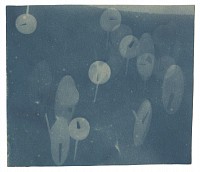BIOGRAPHY

1899-1975
Fritz Kuhr was born in Liège, Belgium, on 10 May 1899. After visiting the large Bauhaus exhibition in Weimar in 1923, he decided to enrol as a student in the art workshop at the Bauhaus. He met Paul Klee there and studied with him until 1930. He later described his contact with Klee, Wassily Kandinsky and László Moholy-Nagy at the Bauhaus as having had a positive influence on his artistic career. Starting in 1926, after the Bauhaus had moved to Dessau, Kuhr served for two years as a student representative on the Bauhaus’s Council of Masters. In 1927, he passed his journeyman’s examination as a mural painter at the Dessau Chamber of Trades. He worked on the Bauhaus’s murals in 1928–1929 as an assistant of the workshop director, Hinnerk Scheper. In 1929–1930, Kuhr himself taught representational drawing and also nude, portrait and figure painting in the third and fourth semesters at the Bauhaus. Six of Kuhr’s photographic works were shown at theWerkbund ‘Film and Photo’ exhibition in Stuttgart, which many of the artists living at the Bauhaus, as well as former Bauhaus members, took part in. When the Nazis came to power in Dessau in 1930, Kuhr decided to leave the Bauhaus and move to Berlin. The same year, he took part in the exhibition ‘Vision and Formal Law’, at which eight of his works were shown, and he was represented internationally starting at the end of the year by the Ferdinand Möller Gallery in Berlin, which arranged presentations of his works at international exhibitions and provided the artist with an annual one-man exhibition on its own premises. In 1934, the Nazi Party denounced Kuhr as a Jew, because of his name; from that time on, he kept away from public appearances. Privately, however, he carried out careful nature studies in order to compensate for weaknesses in his artistic development. In 1936, he met Arnold Budczies, a collector of Munch and Kirchner, who secured Kuhr’s material existence up to the collector’s death in 1943; the art patron purchased more than 100 graphic works and ten paintings by Kuhr during this period.
From 1933 to 1944, Kuhr worked as a decorative painter for the Gustav Neuhaus company and was mainly employed to carry out decorative restoration work in Berlin’s museums. Kuhr’s entire artistic work was destroyed by bombing twice, in 1943 and 1944. The artist was conscripted for military service and subsequently became a prisoner of war in the Soviet Union. From 1946 onward, he lived in Berlin as a freelance artist; he had neither light nor painting materials. Despite this, he made a successful new start through mutual support from other destitute fellow-artists. During this period, Kuhr also worked as a typographer for the satirical paper 'Eulenspiegel'. In 1947, the Franz Gallery in Berlin presented a one-man show of Kuhr’s work. A year later, the former Bauhaus member was appointed as a university lecturer at the Academy of Fine Arts (Hochschule für Bildende Künste) in Berlin, where he trained prospective art teachers. Up to 1971, Kuhr took part in numerous exhibitions in Berlin and throughout the Federal Republic every year, including the travelling exhibition for the Berlin New Group in the USA. Fritz Kuhr died in Berlin on 25 February 1975.
—from Bauhaus Kooperation
